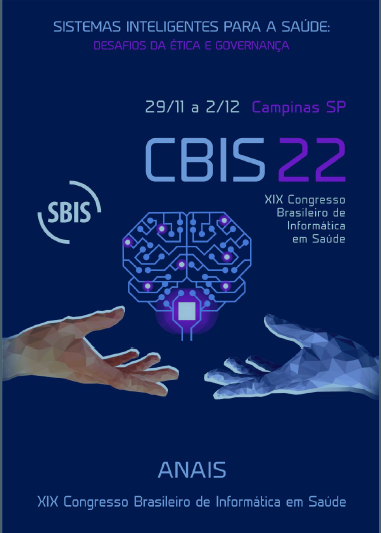Multiprofessional documentation before and after the implementation of a
DOI:
https://doi.org/10.59681/2175-4411.v15.iEspecial.2023.1081Keywords:
Electronic health records, Clinical decision support systems, Nursing informaticsAbstract
Objective:To Compare the multiprofessional documentation of the sepsis institutional protocol in the electronic record, before and after the implementation of a computerized warning system. Method: A quasi-experimental study method was conducted, without a control group and with a pre- and post-intervention design, in which the electronic documentation of the multidisciplinary team of hospital in southern Brazil were compared. Results: The sample comprised 209 protocols: 107 from the previous implementation period (January to May/2018) and 102 from the after implementation period (July to November/2018). In the after implementation period, significant results (p<0.001) were identified both for the frequency and mean verification of vital signs per patient. Conclusion:There was a difference in the compliance of the institutional sepsis protocol after implementation of the computerized warning system.
References
World Health Organization (WHO). Sepsis: Fact sheet. [Internet]. 2018 [cited 2019 Nov 20]. Available from: https://www.who.int/news-room/fact-sheets/detail/sepsis.
Lobo SM, Rezende E, Mendes CL, Oliveira MC de. Mortality due to sepsis in Brazil in a real scenario: the Brazilian ICUs project. Rev Bras Ter Intensiva [Internet]. 2019 [cited 2019 Nov 20];31(1):1–4. doi: http://dx.doi.org/10.5935/0103-507x.20190008.
Instituto Latino Americano de Sepse (ILAS). Roteiro de Implementação de protocolo assistencial gerenciado de sepse: Programa de melhoria de qualidade. 5th ed. São Paulo: ILAS; 2019. Available from: https://ilas.org.br/assets/arquivos/ferramentas/roteiro-de-implementacao.pdf.
Singer M, Deutschman CS, Seymour CW, Shankar-Hari M, Annane D, Bauer M, et al. The third international consensus definitions for sepsis and septic shock (Sepsis-3). JAMA [Internet]. 2016 [cited 2019 Nov 15];315(8):801. doi: https://doi.org/10.1001/jama.2016.0287.
Boniatti MM. Advances in performance, more benefits... the perspectives of rapid response teams. Rev Bras Ter Intensiva [Internet]. 2016 [cited 2019 Nov 9];28(3):217-9. doi:10.5935/0103-507X.20160048.
Jones D, Mitchell I, Hillman K, Story D. Defining clinical deterioration. Resuscitation [Internet]. 2013 [cited 2019 Nov 9];84(8):1029–34. doi: 10.1016/j.resuscitation.2013.01.013.
Kalil AJ, Dias VM de CH, Rocha C da C, Morales HMP, Fressatto JL, Faria RA de. Sepsis risk assessment: a retrospective analysis after a cognitive risk management robot (Robot laura®) implementation in a clinical-surgical unit. Res Biomed Eng. [Internet] 2018 [cited 2019 Nov 10];34(4):310–6. doi: https://doi.org/10.1590/2446-4740.180021.
Pinochet LHC; Lopes AS; Silva JS. Inovações e tendências aplicadas nas tecnologias de informação e comunicação na gestão da saúde. Rev Gest Sist Saúde [Internet]. 2014[cited 2019 Nov 10];3(2):11-29. doi: http://dx.doi.org/10.5585/rgss.v3i2.88.
Lytle KS, Short NM, Richesson RL, Horvath MM. Clinical decision support for nurses: a fall risk and prevention example. Comput Inform Nurs. [Internet]. 2015 [cited 2019 Nov 20];33(12):530–7. doi: 10.1097/CIN.0000000000000192.
Kollef MH, Chen Y, Heard K, LaRossa GN, Lu C, Martin NR, et al. A randomized trial of real-time automated clinical deterioration alerts sent to a rapid response team: Clinical Deterioration Alerts. J Hosp Med. [Internet]. 2014 [cited 2019 Nov 10];9(7):424–9. doi: 10.1002/jhm.2193.
Harris AD et al. The use and interpretation of quasi-experimental studies in medical informatics. J Am Med Inform Assoc. 2006;13(1):16-23. doi:10.1197/jamia.M1749
Conselho Nacional de Saúde do Ministério da Saúde (BR). Resolução no 510, de 07 de abril de 2016. Dispõe sobre as normas aplicáveis a pesquisas em Ciências Humanas e Sociais cujos procedimentos metodológicos envolvam a utilização de dados diretamente obtidos com os participantes ou de informações identificáveis ou que possam acarretar riscos maiores do que os existentes na vida cotidiana. Diário Oficial da União, República Federativa do Brasil, n. 98, 2016 mai. 24; seção 1. p. 44-6.
Fagundes, A. Relacionar dados epidemiológicos e eventos de instabilidade clínica com indicadores assistenciais de pacientes com sepse. Relatório de Iniciação Científica da Universidade Federal do Paraná, 2019.
Harley A, Johnston ANB, Denny KJ, Keijzers G, Crilly J, Massey D. Emergency nurses’ knowledge and understanding of their role in recognising and responding to patients with sepsis: A qualitative study. Int Emerg Nurs. [Internet] 2019 [cited 2019 Nov 19];43:106–12. doi: 10.1016/j.ienj.2019.01.005.
Bossle MT, Model LCM, Kaieski N, Moreira JK, Lora OS. Escore qSOFA no atendimento pré-hospitalar como predição de sepse e mortalidade hospitalar um estudo de coorte brasileiro. Fórum Internacional de Sepse, Rio de Janeiro, 2019.
Goulart L de S, Ferreira Júnior MA, Sarti ECFB, Sousa ÁFL de, Ferreira AM, Frota OP. Are nurses updated on the proper management of patients with sepsis? Esc Anna Nery. [Internet] 2019 [cited 2019 Nov 19];23(4):e20190013. doi: 10.1590/2177-9465-EAN-2019-0013.
Mellhammar L, Linder A, Tverring J, Christensson B, Boyd JH, Sendi P, et al. News2 is
superior to qsofa in detecting sepsis with organ dysfunction in the emergency department. J Clin Med. [Internet] 2019 [cited 2019 Nov 15];8(8):1128. doi: 10.3390/jcm8081128.
Lavin MA; Harper E; Barr N. Health information technology, patient safety, and professional nursing care documentation in acute care settings. Online J Issues Nurs. [Internet] 2015 [cited 2019 Nov 15];20(2). doi: 10.3912/OJIN.Vol20No02PPT04.
Westphal GA, Lino AS. Systematic screening is essential for early diagnosis of severe sepsis and septic shock. Rev Bras Ter Intensiva [Internet]. 2015 [cited 2019 Nov 9];27(2). doi: 10.5935/0103-507X.20150018.
Shankar-Hari M, Harrison DA, Ferrando-Vivas P, Rubenfeld GD, Rowan K. Risk factors at index hospitalization associated with longer-term mortality in adult sepsis survivors. JAMA Netw Open. [Internet] 2019 [cited 2019 Nov 9];2(5):e194900. doi: 10.1001/jamanetworkopen.2019.4900.
Downloads
Published
How to Cite
Issue
Section
License
Copyright (c) 2023 Luciana Schleder Gonçalves, Maria Luiza de Medeiros Amaro

This work is licensed under a Creative Commons Attribution-NonCommercial-ShareAlike 4.0 International License.
Submission of a paper to Journal of Health Informatics is understood to imply that it is not being considered for publication elsewhere and that the author(s) permission to publish his/her (their) article(s) in this Journal implies the exclusive authorization of the publishers to deal with all issues concerning the copyright therein. Upon the submission of an article, authors will be asked to sign a Copyright Notice. Acceptance of the agreement will ensure the widest possible dissemination of information. An e-mail will be sent to the corresponding author confirming receipt of the manuscript and acceptance of the agreement.

